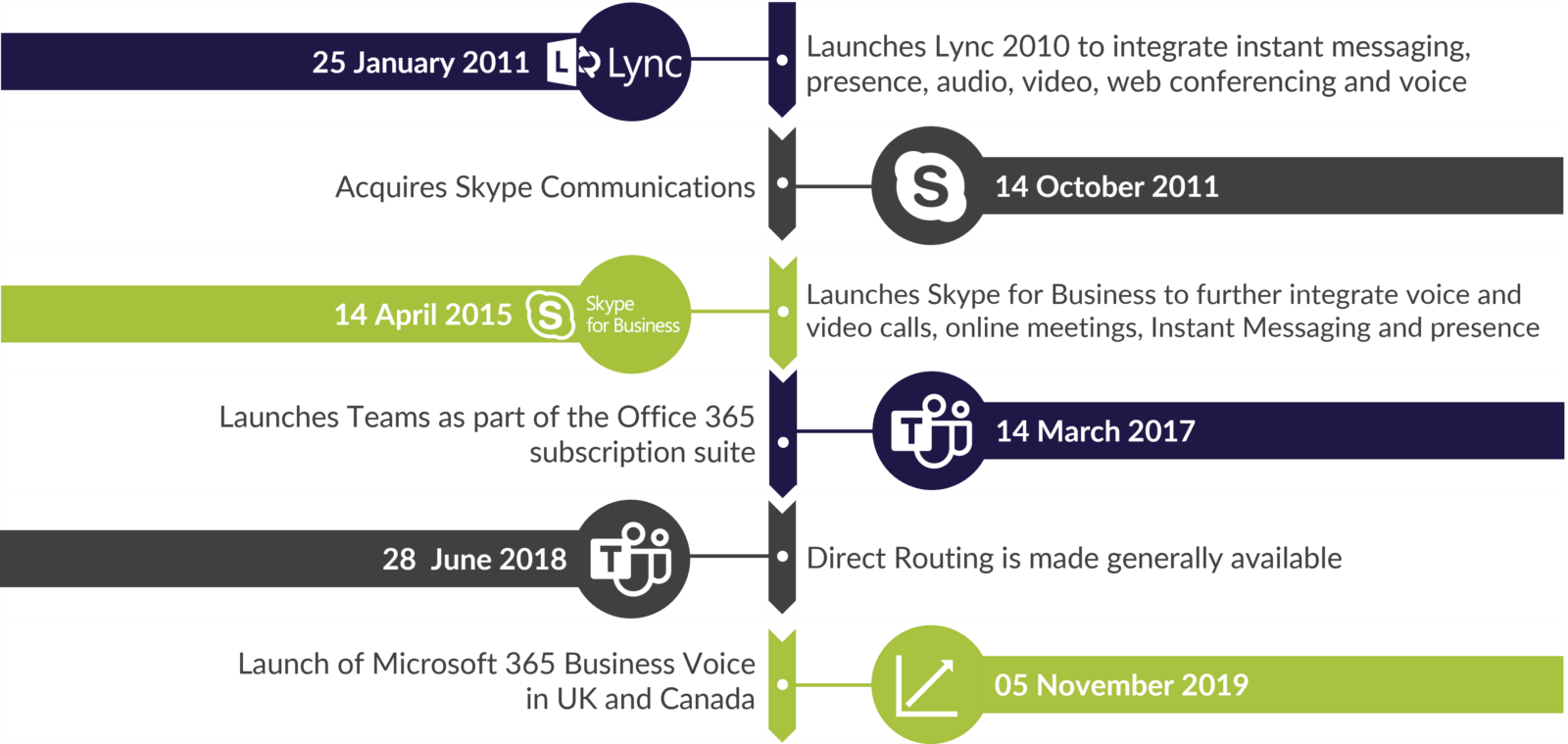Microsoft Teams is Microsoft’s fastest-growing business application of all time! In this blog, we chart the rise of Microsoft Teams and its move into voice.
From humble beginnings in an Albuquerque garage, the Microsoft story is the stuff of legends. Started by Bill Gates and Paul Allen in 1975, the company focused on developing software for an early PC. By the late 1980s, it was the world’s largest PC software company.
Since then, Microsoft has continued to evolve, innovate and reinvent itself, often at breakneck speed. Its journey into Unified Communications and telephony is no different.
From an Internal Memo to Microsoft Teams
Microsoft’s journey into communications started on 26 May 1995 when Bill Gates sent the now famous Internet tidal wave memo to his senior management team. It saw a near immediate shift in the company’s focus to realign its offerings and product lines to the World Wide Web. Today, many regard Microsoft as one of few major companies that acted fast enough to be part of the Internet from the start.
After launching MSN Messenger, an instant messaging platform in 1999, a major development came in 2007 when Microsoft staked its claim in the VoIP market. Known as Office Communications Server 2007, it brought together VoIP, presence, instant messaging and conferencing. At the same time, the company launched its first videoconferencing system known as RoundTable. Jeff Raikes, president of Microsoft’s Business Division called it the end of an era: “The era of dialling blind, the era of playing phone tag, the era of voicemail jail…that era is ending.”
Over the next 20 years, they moved quickly and continued to disrupt and shake-up the Unified Communications market. Some major milestones included the launch of Lync in 2011, acquiring Skype Communications in 2011, and launching Skype for Business in 2015. Fast forward to 2017 when Microsoft irrevocably changed the Unified Communications game with the launch of Teams. Initially available as part of the subscription-based Office 365 suite, a free version was introduced little over a year later. By the end of 2018, Microsoft Teams was the most widely used programme of its kind.
The Microsoft Journey: Key Milestones from 2011 to 2019

From Microsoft Teams to the Leading Unified Communications Provider
Enter 2020. As the COVID-19 pandemic swept through the world, so did new ways of doing business. Remote working became the norm and companies had very little time to adapt and facilitate the near-immediate shift.
By then, Microsoft Teams was a familiar interface with approximately 20 million active daily users. Combined with the launch of its 365 Business Voice suite at the beginning of November 2019, Microsoft Teams was (quite literally) in the right place, at the right time and the application grew at an astounding rate.

Source: Cavell Group
Microsoft now sits at the top of the Gartner Magic Quadrant for UCaaS 2022. With this achievement Microsoft acknowledge that telephony is at the core of their customers’ needs.
Teams Telephony: From Basic Feature to Key Business Driver
Telephony was always included as an add-on to Microsoft Teams. From a user perspective, this meant that only one application was ever needed during a workday, from accessing files, editing, collaborating, messaging and making external calls. As the application grew, so did the need for replacing and / or integrating existing phone platforms with Microsoft Teams. This saw Microsoft quickly developing its telephony solution from a feature to one of its key business drivers.
A particular effort was put into infrastructure support for Carriers and offering more flexible technologies to provide services. This included the Azure for Operators initiative, Operator Connect and recently announced at Microsoft Ignite, Microsoft Teams Phone Mobile.
This pace of innovation is expected to continue with telephony recently confirmed as a “huge new opportunity” during its FY2021 Q4 Earnings call: “We have nearly 80 million monthly active Teams Phone users, with total calls surpassing 1 billion in a single month this quarter. And we’re just getting started.”
Where to from here
The sky is the limit, especially when it comes to the PSTN calling potential that service providers and carriers can tap into. Let’s look at the numbers.
Microsoft recently shared that it had 345 million paid seats for Office 365, a 17% year-on-year increase in the product’s commercial revenue. Of course, this translates into direct growth for Microsoft Teams which is estimated to add 3 million new users per month to its already impressive 280 million monthly active users.
From a Teams Phone perspective, 80 million are active monthly users but only 10 – 20% are currently enabled for PSTN calling. This number is expected to double over the next three to four years, posing a huge window of opportunity for Carriers and Service Providers. Combined with global forecasts showing an accelerated growth phase of Teams telephony, user numbers are set to soar.
